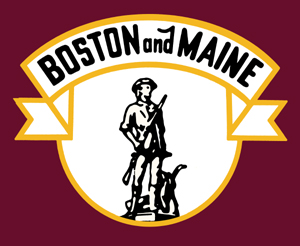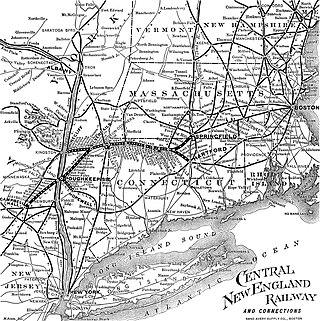
Gallatin County is a county located in the U.S. state of Illinois. According to the 2020 census, it has a population of 4,946, making it the third-least populous county in Illinois. Its county seat is Shawneetown. It is located in the southern portion of Illinois known locally as Little Egypt. Located at the mouth of the Wabash River, Gallatin County, along with neighboring Posey County, Indiana, and Union County, Kentucky form the tri-point of the Illinois-Indiana-Kentucky Tri-State Area.

Omaha is a village in Gallatin County, Illinois, United States. The population was 209 at the 2020 census.

The Boston and Maine Railroad was a U.S. Class I railroad in northern New England. Originally chartered in 1835, it became part of what was the Pan Am Railways network in 1983.

Southern Illinois is a region of the U.S. state of Illinois comprising the southern third of the state, principally south of Interstate 70. Part of downstate Illinois, it is bordered by the two most voluminous rivers in the United States: the Mississippi below its connection with the Missouri River to the west and the Ohio River to the east and south, with the Wabash as a tributary. Some areas of Southern Illinois are known historically as Little Egypt.
The Little Miami Railroad was a railway of southwestern Ohio, running from the eastern side of Cincinnati to Springfield, Ohio. By merging with the Columbus and Xenia Railroad in 1853, it created the first through-rail route from the important manufacturing city of Cincinnati to the state capital, Columbus. In this period, railroads were important for creating connections between the important waterways of the Great Lakes and the Ohio River, which were major transportation routes for products to other markets.

The Illinois Central Railroad, sometimes called the Main Line of Mid-America, was a railroad in the Central United States. Its primary routes connected Chicago, Illinois, with New Orleans, Louisiana, and Mobile, Alabama, and thus, the Great Lakes to the Gulf of Mexico. Another line connected Chicago west to Sioux City, Iowa (1870), while smaller branches reached Omaha, Nebraska (1899) from Fort Dodge, Iowa, and Sioux Falls, South Dakota (1877), from Cherokee, Iowa. The IC also ran service to Miami, Florida, on trackage owned by other railroads.

The Gateway Western Railway was a Class II railroad that operated 408 miles of former Chicago and Alton Railroad track between Kansas City and St. Louis, Missouri. It also operated between Kansas City, Missouri, and Springfield, Illinois on the old Alton Railroad line that eventually was the Chicago, Missouri and Western Railway.

The Central New England Railway was a railroad from Hartford, Connecticut, and Springfield, Massachusetts, west across northern Connecticut and across the Hudson River on the Poughkeepsie Bridge to Maybrook, New York. It was part of the Poughkeepsie Bridge Route, an alliance between railroads for a passenger route from Washington to Boston, and was acquired by the New York, New Haven & Hartford Railroad in 1904. The New Haven ran the CNE as a separate company until finally merging it in 1927. The vast majority of the system was abandoned by the 1930s and 1940s. Surviving portions of the Central New England Railway are operated by the Central New England Railroad and the Housatonic Railroad.

The Boston and Albany Railroad was a railroad connecting Boston, Massachusetts to Albany, New York, later becoming part of the New York Central Railroad system, Conrail, and CSX Transportation. The line is currently used by CSX for freight. Passenger service is provided on the line by Amtrak, as part of their Lake Shore Limited service, and by the MBTA Commuter Rail system, which owns the section east of Worcester and operates it as its Framingham/Worcester Line.

Illinois Route 13 is a major east–west state route in southern Illinois. Illinois 13 has its western terminus at Centreville at Illinois Route 157 and its eastern terminus at the Kentucky state line and the Ohio River, at Kentucky Route 56. This is a distance of 151.54 miles (243.88 km).
The Pittsburgh, Fort Wayne and Chicago Railway was a major part of the Pennsylvania Railroad system, extending the PRR west from Pittsburgh, Pennsylvania, via Fort Wayne, Indiana, to Chicago, Illinois. It included the current Norfolk Southern-owned Fort Wayne Line east of Crestline, Ohio, to Pittsburgh, and the Fort Wayne Secondary, owned by CSX, from Crestline west to Tolleston in Gary, Indiana. CSX leased its entire portion in 2004 to the Chicago, Fort Wayne and Eastern Railroad (CFE). The remaining portion of the line from Tolleston into Chicago is now part of the Norfolk Southern's Chicago District, with a small portion of the original PFW&C trackage abandoned in favor of the parallel lines of former competitors which are now part of the modern NS system.

The Pittsburgh, Cincinnati, Chicago and St. Louis Railroad, commonly called the Pan Handle Route, was a railroad that was part of the Pennsylvania Railroad system. Its common name came from its main line, which began at Pittsburgh, Pennsylvania, crossed the Northern Panhandle of West Virginia, and continued west to Bradford, Ohio, where it split into a northern line to Chicago and a southern one through Indianapolis, Indiana, to East St. Louis, Illinois.

The Alton Railroad was the final name of a railroad linking Chicago to Alton, Illinois; St. Louis, Missouri; and Kansas City, Missouri. Its predecessor, the Chicago and Alton Railroad, was purchased by the Baltimore and Ohio Railroad in 1931 and was controlled until 1942 when the Alton was released to the courts. On May 31, 1947, the Alton Railroad was merged into the Gulf, Mobile and Ohio Railroad. Jacob Bunn had been one of the founding reorganizers of the Chicago & Alton Railroad Company during the 1860s.
Goshen Road was an early road that ran from Old Shawneetown, Illinois, on the Ohio River, northwest to the Goshen Settlement, near Glen Carbon, Illinois, near the Mississippi River. In the early 19th century, this was the main east/west road in Illinois.
The Cleveland, Columbus, Cincinnati and Indianapolis Railway (CCC&I) was formed from the merger of the Cleveland, Columbus and Cincinnati Railroad (CC&C) with the Bellefontaine Railway in 1868. The Bellefontaine had been formed by a merger of the Bellefontaine and Indiana Railroad and the Indianapolis, Pittsburgh and Cleveland Railroad in 1864. Two key figures in its construction were Cyrus Ball and Albert S. White.

Springfield Union Station in Springfield, Illinois, is a former train station and now part of the complex of buildings that together form the Abraham Lincoln Presidential Library and Museum. It is listed on the National Register of Historic Places, and is located at 500 East Madison Street in downtown Springfield, adjacent to the Lincoln Presidential Library.
The following is a brief history of the North American rail system, mainly through major changes to Class I railroads, the largest class by operating revenue.

The Wabash Railroad was a Class I railroad that operated in the mid-central United States. It served a large area, including track in the states of Ohio, Indiana, Illinois, Iowa, Michigan, and Missouri and the province of Ontario. Its primary connections included Chicago, Illinois; Kansas City, Missouri; Detroit, Michigan; Buffalo, New York; St. Louis, Missouri; and Toledo, Ohio.
The Gilman, Clinton and Springfield Railroad was a railroad of 111 miles (179 km) in length, chartered in 1867, that operated from 1871 until 1877 in the U.S. state of Illinois. It provided service from Springfield, the state capital, to Gilman, a junction point on the main line of the much larger Illinois Central Railroad. After operation for a short period as an independent short line, the Gilman, Clinton and Springfield underwent financial failure and was merged into the Chicago and Springfield Railroad, an affiliate of the Illinois Central.

The Ohio Southern Railroad operated between Ironton, Ohio, and Lima, Ohio, from 1893 and 1905. Beginning in 1878 as the narrow gauge Springfield, Jackson and Pomeroy Railroad, it ran from Jackson-Wellston, Jackson County to Springfield, Ohio. The line was converted to a standard gauge by 1880 and renamed the Ohio Southern Railroad in 1881. From Jeffersonville, branch lines were started towards Columbus to the northeast and Cincinnati to the southwest, but never completed. By September 1893, the Ohio Southern had reached north to Lima with a bridge over the Great Miami River at Quincy. At Lima, the freight could link to the Lima Northern Railway for points further north. In 1898, the Lima Northern became the Detroit and Lima Northern Railroad (D&LN). Ohio Southern depots continue to stand in St. Johns, Uniopolis, Jackson Center, Quincy, and Rosewood.















